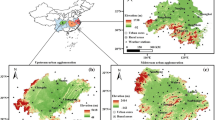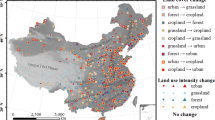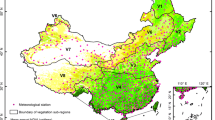Abstract
In the context of global change, it is essential to promote the rational development and utilization of land resources, improve the quality of regional ecological environment, and promote the harmonious development of human and nature for the regional sustainability. We identified land use/land cover types in northern China from 2001 to 2018 with ENVI images and ArcGIS software. Meteorological data were selected from 292 stations in northern China, the potential evapotranspiration was calculated with the Penman—Monteith formula, and reanalysis humidity and observed humidity data were obtained. The reanalysis minus observation (RMO, i.e., the difference between reanalysis humidity and observed humidity) can effectively characterize the impact of different land use/land cover types (forestland, grassland, cultivated land, construction land, water body and unused land) on surface humidity in northern China in the early 21st century. The results showed that from 2001 to 2018, the area of forestland expanded (increasing by approximately 1.80×104 km2), while that of unused land reduced (decreasing by approximately 5.15×104 km2), and the regional ecological environment was improved. Consequently, land surface in most areas of northern China tended to be wetter. The contributions of land use/land cover types to surface humidity changes were related to the quality of the regional ecological environment. The contributions of the six land use/land cover types to surface humidity were the highest in northeastern region of northern China, with a better ecological environment, and the lowest in northwestern region, with a fragile ecological environment. Surface humidity was closely related to the variation in regional vegetation coverage; when the regional vegetation coverage with positive (negative) contributions expanded (reduced), the land surface became wetter. The positive contributions of forestland and water body to surface humidity were the greatest. Unused land and construction land were associated with the most serious negative contributions to surface humidity. Affected by the regional distribution pattern of vegetation, surface humidity in different seasons decreased from east to west in northern China. The seasonal variation in surface humidity was closely related to the growth of vegetation: surface humidity was the highest in summer, followed by autumn and spring, and the lowest in winter. According to the results, surface humidity is expected to increase in northeastern region of northern China, decrease in northern region, and likely increase in northwestern region.
Similar content being viewed by others
References
Allen R G, Jensen M E, Wright J L, et al. 1989. Operational estimates of reference evapotranspiration. Agronomy Journal, 81(4): 650–662.
Allen R G, Pereira L S, Raes D, et al. 1998. Crop evapotranspiration: guidelines for computing crop water requirements. Fao Irrigation and Drainage Paper 56. Rome: Food and Agriculture Organization of the United Nations.
Bian J C, Chen H B, Vömel H, et al. 2011. Intercomparison of humidity and temperature sensors: GTS1, Vaisala RS80, and CFH. Advances in Atmospheric Sciences, 28(1): 139–146.
Bian J J, Hao Z X, Zheng J Y, et al. 2013. The shift on boundary of climate regionalization in China from 1951 to 2010. Geographical Research, 32(7): 1179–1187. (in Chinese)
Bian X H, Liu Y, Ding Q Q, et al. 2019. Response of land use and cover change to urban heat island effect in Huzhou City, Zhejiang Province. Bulletin of Soil and Water Conservation, 39(3): 263–269. (in Chinese)
Braswell B H, Schimel D S, Linder E, et al. 1997. The response of global terrestrial ecosystems to interannual temperature variability. Science, 278(5339): 870–873.
Buitenwerf R, Rose L, Higgins S I. 2015. Three decades of multi-dimensional change in global leaf phenology. Nature Climate Change, 5(4): 364–368.
Cao L J, Zhang D F, Zhang Y, et al. 2010. Sensitivity research of the effects of land use change on climate and runoff over the Yangtze River basin. Chinese Journal of Atmospheric Sciences, 34(4): 726–736. (in Chinese)
Dai X Q, Shen R Q, Wang J, et al. 2021. Change detection of land use in Henan Province based on GEE remote sensing cloud platform. Journal of Geomatics Science and Technology, 38(3): 287–294.
Du Y D, Liu Z X, Zhang Y F. 2001. Evaluaiton of two reference crop evapotranspiration calculation methods. Journal of Henan Agricultural University, 35(1): 57–61. (in Chinese)
Dumont B, Andueza D, Niderkorn V, et al. 2015. A meta-analysis of climate change effects on forage quality in grasslands: specificities of mountain and M editerranean area. Grass and Forage Science, 70(2): 239–254.
Fezzi C, Harwood A R, Lovett A A, et al. 2015. The environmental impact of climate change adaptation on land use and water quality. Nature Climate Change, 5(3): 255–260.
Fu B J, Yu D D, Lü N. 2017. An indicator system for biodiversity and ecosystem services evaluation in China. Acta Ecologica Sinica, 37(2): 341–348. (in Chinese)
Gao J B, Jiao K W, Wu S H. 2019. Investigating the spatially heterogeneous relationships between climate factors and NDVI in China during 1982 to 2013. Journal of Geographical Sciences, 29(10): 1597–1609.
Han H Q, Zhang C Q, Wang Y, et al. 2019. Spatial-temporal variation and influencing factors of dry and wet condition in Guizhou Province between 1961 and 2014. Journal of Shanxi Agricultural University (Nature Science Edition), 39(4): 106–112. (in Chinese)
Hua W J, Chen H S, Li X. 2014. Review of land use and land cover change in China and associated climatic effects. Advances in Earth Science, 29(9): 1025–1036. (in Chinese)
Hulme M, Marsh R, Jones P D. 1992. Global changes in a humidity index between 1931–1960 and 1961–1990. Climate Research, 2: 1–22.
Hurtt G C, Chini L P, Frolking S, et al. 2011. Harmonization of land-use scenarios for the period 1500–2100: 600 years of global gridded annual land-use transitions, wood harvest, and resulting secondary lands. Climatic Change, 109(1–2): 117–161.
IPCC. 2019. Climate Change and Land: An IPCC special report on climate change, desertification, land degradation, sustainable land management, food security, and greenhouse gas fluxes in terrestrial ecosystems. Shukla P R, Skea J, Calvo Buendia E, et al. (eds.). [2021-08-12]. https://spiral.imperial.ac.uk/handle/10044/1/76618.
Jia Y Q, Zhang B. 2019. Relationship of dry-wet climate changes in Northern China in the past 57 years with Pacific Decadal Oscillation (PDO). Acta Pedologica Sinica, 56(5): 1085–1097. (in Chinese)
Jing Y Q, Zhang F, Chen L H, et al. 2017. Investigation on eco-environmental effects of land use/cover-landscape pattern and climate change in Ebinur Lake Wetland Nature Reserve. Acta Scientiae Circumstantiae, 37(9): 3590–3601. (in Chinese)
Kalnay E, Cai M. 2003. Impact of urbanization and land-use change on climate. Nature, 423: 528–531.
Kaufmann R K, Seto K C, Schneider A, et al. 2007. Climate response to rapid urban growth: Evidence of a human-induced precipitation deficit. Journal of Climate, 20: 2299–2306.
Lai L, Huang X, Yang H, et al. 2016. Carbon emissions from land-use change and management in China between 1990 and 2010. Science Advances, 2(11): e1601063, doi: https://doi.org/10.1126/sciadv.1601063.
Li S Y, Chen H B, Li W. 2008. The impact of urbanization on city climate of Beijing region. Plateau Meteorology, 27(5): 1102–1110. (in Chinese)
Li S Y, Liu X P, Li X, et al. 2017. Simulation model of land use dynamics and application: progress and prospects. Journal of Remote Sensing, 21(3): 329–340. (in Chinese)
Lin L, Fan H, Jin Y. 2020. Multi-scale and multi-model simulation of land use/land cover change in the mountainous county: A case study of Mengla County in Yunnan Province, China. Mountain Research, 38(4): 630–642. (in Chinese)
Liu J Y, Zhang Z X, Xu X L, et al. 2010. Spatial patterns and driving forces of land use change in China during the early 21st century. Journal of Geographical Sciences, 20(4): 483–494.
Liu J Y, Kuang W H, Zhang Z X, et al. 2014. Spatiotemporal characteristics, patterns and causes of land use changes in China since the late 1980s. Acta Geographica Sinica, 69(1): 3–14. (in Chinese)
Luo Q H, Ning H S, Chen Q M. 2016. Trends of surface dry-wet state of Ganjiahu in Xinjiang based on humid index. Arid Zone Research, 33(5): 921–926. (in Chinese)
Mao F, Sun H, Yang H L. 2011. Research progress in dry/wet climate zoning. Progress in Geography, 30(1): 17–26. (in Chinese)
Mao R X, Chen G, Zhang S Q. 2017. Several problems in the construction of the Three-North Shelter Forest Program and suggestions for its countermeasures. Protection Forest Science and Technology, (10): 58–59, 61. (in Chinese)
Mooney H A, Duraiappah A, Larigauderie A. 2013. Evolution of natural and social science interactions in global change research programs. Proceedings of the National Academy of Sciences of the United States of America, 110(Suppl 1): 3665–3672.
National Research Council. 2005. Radiative Forcing of Climate Change: Expanding the Concept and Addressing Uncertainties. Washington D.C.: National Academies Press, 1–208.
Oleson K, Bonan G Feddema J, et al. 2008. An urban parameterization for a global climate model. Part I: Formulation and evaluation for two cities. Journal of Applied Meteorology and Climatology, 47(4): 1038–1060.
Pitman A J, Noblet-Ducoudé N, Cruz F T, et al. 2009. Uncertainties in climate responses to past land cover change: First results from the LUCID intercomparison study. Geophysical Research Letters, 36(14): L14814, doi: https://doi.org/10.1029/2009GL039076.
Shao P, Zeng X D. 2012. Progress in the study of the effects of land use and land cover change on the climate system. Climatic and Environmental Research, 17(1): 103–111. (in Chinese)
Sterling S M, Ducharne A, Polcher J. 2012. The impact of global land-cover change on the terrestrial water cycle. Nature Climate Change, 3(4): 385–390.
Sun L, Wu G X, Sun S F. 2000. Numerical simulations of effects of land surface processes on climate implementing of SSiB in IAP/LASG AGCM L9R15 and its performance. Acta Meteorologica Sinica, 58(2): 179–193. (in Chinese)
Sun Q, Qi W, Yu X Y. 2021. Impacts of land use change on ecosystem services in the intensive agricultural area of North China based on Multi-scenario analysis. Alexandria Engineering Journal, 60(1): 1703–1716.
Tian H Q, Chen G, Zhang C, et al. 2012. Century-scale response of ecosystem carbon storage to multifactorial global change in the Southern United States. Ecosystems, 15: 674–694.
Tuffour-Mills D, Antwi-Agyei P, Addo-Fordjour P. 2020. Trends and drivers of land cover changes in a tropical urban forest in Ghana. Trees, Forests and People, 2, doi: https://doi.org/10.1016/j.tfp.2020.100040.
Verbeeck H, Kearsley E. 2015. The importance of including lianas in global vegetation models. Proceedings of the National Academy of Sciences of the United States of America, 113(1): E4, doi: https://doi.org/10.1073/pnas.1521343113.
Wang J H, Zhang L Y. 2008. Systematic errors in global radiosonde precipitable water data from comparisons with ground-based GPS measurements. Journal of Climate, 21(10): 2218–2238.
Wang M N, Ha Z, Zhang Q Y. 2016. Impact of land use and cover change in the semi-arid regions of China on the temperature in the early 21st century. Climatic and Environmental Research, 21(1): 65–77. (in Chinese)
Wang Q, Zhang Q P, Zhou W. 2012. Grassland coverage changes and analysis of the driving forces in Maqu County. Physics Procedia, 33: 1292–1297.
Wang X L, Liu Y, Zhang Y, et al. 2021. Exploration and prediction of land use/cover change in western Jilin province based on Ca-markov model. Science Technology and Engineering, 21(19): 7942–7948. (in Chinese)
Weinert M, Mathis M, Kröncke I, et al. 2016. Modelling climate change effects on benthos: Distributional shifts in the North Sea from 2001 to 2099. Estuarine, Coastal and Shelf Science, 175(20): 157–168.
Yang X C, Zhang Y L, Liu L S, et al. 2009. Sensitivity of surface air temperature change to land types in China. Science in China Series D-Earth Sciences, 52(8): 1207–1215.
Yao W, Ma Y, Gao L N. 2017. Comparison of relative humidity data between L-band and 59–701 sounding system. Journal of Applied Meteorological Science, 28(2): 218–226. (in Chinese)
Yuan Q Z, Wu S H, Dai E F, et al. 2017. Spatio-temporal variation of the wet-dry conditions from 1961–2015 in China. Science China: Earth Sciences, 47(11): 1339–1348.
Zhang C L, Chen F, Miao S G, et al. 2009. Impacts of urban expansion and future green planting on summer precipitation in the Beijing metropolitan area. Journal of Geophysical Research, 114: D02116, doi: https://doi.org/10.1029/2008JD010328.
Zhang X R, Song W, Lang Y Q, et al. 2020. Land use changes in the coastal zone of China’s Hebei Province and the corresponding impacts on habitat quality. Land Use Policy, 99, doi: https://doi.org/10.1016/j.landusepol.2020.104957.
Zhang Z X, Liu L M, Jia Y, et al. 2009. Climatic ecological adaptation of shelter forests in Three-North Regions. Chinese Journal of Ecology, 28(9): 1696–1701. (in Chinese)
Zhao N, Liu S H, Yu H Y. 2011. Urbanization effects on local climate in Beijing in recent 48 years. Chinese Journal of Atmospheric Sciences, 35(2): 373–385. (in Chinese)
Zheng S Y, Liu S H. 2008. Urbanization effect on climate in Beijing. Climate and Environmental Research, 13(2): 123–133. (in Chinese)
Acknowledgements
This study was funded by the National Natural Science Foundation of China (42071112, 41771110). We thank the editors and anonymous reviewers whose insights and suggestions have greatly improved this manuscript.
Author information
Authors and Affiliations
Corresponding author
Rights and permissions
About this article
Cite this article
Jin, J., Yin, S. & Yin, H. Impact of land use/land cover types on surface humidity in northern China in the early 21st century. J. Arid Land 14, 705–718 (2022). https://doi.org/10.1007/s40333-022-0055-3
Received:
Revised:
Accepted:
Published:
Issue Date:
DOI: https://doi.org/10.1007/s40333-022-0055-3




